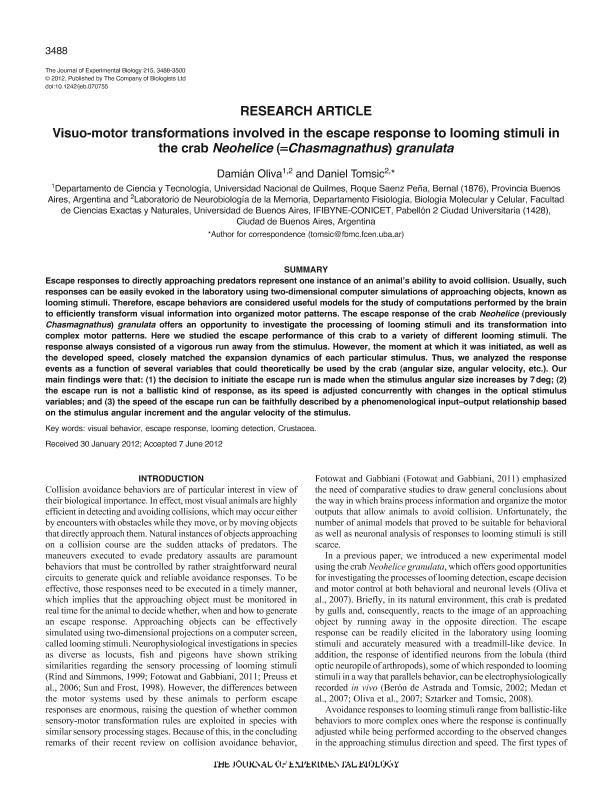Artículo
Visuo-motor transformations involved in the escape response to looming stimuli in the crab Neohelice (=Chasmagnathus) granulata
Fecha de publicación:
2012
Editorial:
Company of Biologists
Revista:
Journal of Experimental Biology
ISSN:
0022-0949
Idioma:
Inglés
Tipo de recurso:
Artículo publicado
Clasificación temática:
Resumen
Escape responses to directly approaching predators represent one instance of an animal s ability to avoid collision. Usually, such responses can be easily evoked in the laboratory using two-dimensional computer simulations of approaching objects, known as looming stimuli. Therefore, escape behaviors are considered useful models for the study of computations performed by the brain to efficiently transform visual information into organized motor patterns. The escape response of the crab Neohelice (previously Chasmagnathus) granulata offers an opportunity to investigate the processing of looming stimuli and its transformation into complex motor patterns. Here we studied the escape performance of this crab to a variety of different looming stimuli. The response always consisted of a vigorous run away from the stimulus. However, the moment at which it was initiated, as well as the developed speed, closely matched the expansion dynamics of each particular stimulus. Thus, we analyzed the response events as a function of several variables that could theoretically be used by the crab (angular size, angular velocity, etc.). Our main findings were that: (1) the decision to initiate the escape run is made when the stimulus angular size increases by 7deg; (2) the escape run is not a ballistic kind of response, as its speed is adjusted concurrently with changes in the optical stimulus variables; and (3) the speed of the escape run can be faithfully described by a phenomenological input–output relationship based on the stimulus angular increment and the angular velocity of the stimulus.
Palabras clave:
Visual Behaviors
,
Escape Response
,
Crabs
,
Collision Avoidance
Archivos asociados
Licencia
Identificadores
Colecciones
Articulos(IFIBYNE)
Articulos de INST.DE FISIOL., BIOL.MOLECULAR Y NEUROCIENCIAS
Articulos de INST.DE FISIOL., BIOL.MOLECULAR Y NEUROCIENCIAS
Citación
Oliva, Damian Ernesto; Tomsic, Daniel; Visuo-motor transformations involved in the escape response to looming stimuli in
the crab Neohelice (=Chasmagnathus) granulata; Company of Biologists; Journal of Experimental Biology; 215; -1-2012; 3488-3500
Compartir
Altmétricas




